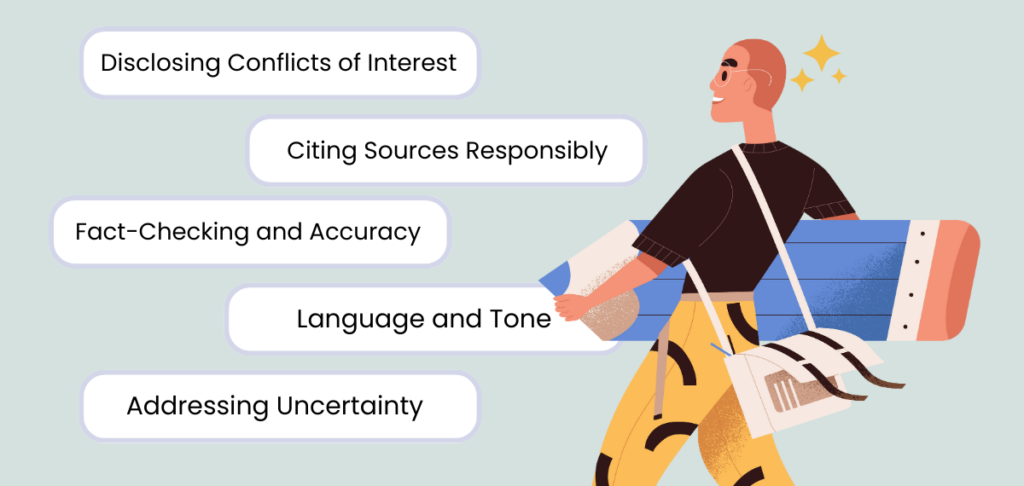Transparency is a foundational principle in writing to support honesty and clarity in communication. In the context of writing, transparency refers to providing readers and clients with accurate information about the content, process, and any relevant factors that might influence work.
When establishing trust and credibility with clients and readers, transparency is important for freelance writers. However, it also presents unique challenges.
Independent professionals must navigate a diverse set of clients and subject matters. Balancing transparency with client confidentiality can be challenging, especially when dealing with sensitive information that must be protected. Freelance writers often encounter the need to promote themselves and their skills.
It can be challenging to showcase expertise without appearing overly self-promotional. Freelance writers may also face difficulties disclosing relationships or biases that could influence their work.
This article thoroughly examines how to foster transparency with clients throughout the writing process and effectively showcase your expertise. So, keep reading to learn the tips needed to further your success in freelance writing.

How Can You Build Transparency in Client Relations?
Transparency is critical to establishing a strong and trusting relationship with clients. By being open and honest in your communication, you can ensure that both parties clearly understand expectations, limitations, and project progress.
Setting Clear Expectations
From the start, it’s important to set clear expectations with your client. Outlining clearly what you will provide and what you expect from the client helps avoid misunderstandings and ensures that both parties are on the same page.
Handling Revisions and Feedback
Revisions and feedback are a natural part of the creative process. Always actively listen to the client’s feedback, respond in a timely manner, and be open to making changes and revisions.
Acknowledging Limitations
As a freelancer, it’s essential to acknowledge your limitations. Be honest with yourself and your clients about your areas of expertise and what you can realistically deliver. If a project falls outside your skill set or comfort zone, it’s better to be transparent from the beginning and discuss potential alternatives or seek additional support.
How Can You Build Transparency in the Writing Itself?

Disclosing conflicts of interest and being transparent about affiliations, relationships, and sponsored content is crucial for maintaining integrity and building trust with your audience. Here are some guidelines to follow:
Disclosing Conflicts of Interest
Be aware of potential conflicts of interest when discussing a particular topic or endorsing a product or service. This could include personal relationships or financial interests, for example.
Reveal Affiliations with Organizations or Products Discussed
When discussing a topic or recommending a product or service where a conflict of interest exists, make a clear disclosure. State the nature of the conflict and how it may impact your viewpoint or recommendations.
Acknowledge Previous or Existing Relationships That Could Bias Viewpoints
When discussing a topic or providing analysis, strive to be objective and unbiased. However, if you have a previous or existing relationship that could potentially bias your viewpoint, acknowledge it. Explain the nature of the relationship and how it may influence your perspectives or opinions.
Disclose Sponsored Content or Paid Partnerships
If you create content that is sponsored or part of a paid partnership, clearly label it as such. Use labels such as “sponsored,” “advertisement,” or “in partnership with” to ensure transparency.
Clearly communicate to your audience that although the content is sponsored, your opinions and recommendations are based on your genuine assessment.
Citing Sources Responsibly
Citing sources is an essential practice in writing that demonstrates integrity and acknowledges the work of others.
Use Credible Sources and Avoid Plagiarism
Plagiarism is the act of using someone else’s words, ideas, or work without giving proper credit. It is crucial to avoid plagiarism by accurately attributing and referencing all sources used in your writing.
Prioritize credible sources such as peer-reviewed journals, reputable websites, books from established publishers, and expert opinions. Credible sources provide reliable and accurate information.
Employ Proper Citation Formats (MLA, Chicago, APA, etc.)
Different writing styles may require specific citation formats, such as MLA (Modern Language Association), APA (American Psychological Association), Chicago Manual of Style, or Harvard. Familiarize yourself with the citation style relevant to your field.
Consider Offering a Resources List or Bibliography
At the end of your work, include a comprehensive list of all the sources you cited or consulted. This list, commonly called a bibliography or reference list, provides readers with the necessary information to locate the original sources. You can also consider providing a separate resources list or recommended reading section.
Fact-Checking and Accuracy
Fact-checking and maintaining writing accuracy ensure your work’s credibility and reliability.
Verify Information with Multiple Sources
When conducting research, rely on multiple reputable sources to cross-reference information. This helps minimize the risk of relying on inaccurate or misleading information.
Distinguish Between Fact and Opinion
Differentiate between factual information and opinions. Facts are verifiable and supported by evidence, while opinions are personal viewpoints.
Quickly Address and Correct Any Errors Found After Publication
If errors are identified after publication, it is important to address them promptly and transparently to ensure the integrity of your work. Acknowledge the mistake, provide the correct information, and clearly communicate the correction.
Language and Tone
Language and tone play a crucial role in writing, shaping how readers present and perceive information.
Be Mindful of Potentially Harmful Language, Stereotypes, and Assumptions
Be aware of the potential impact of your words and strive to promote inclusivity, respect, and understanding. Challenge assumptions and stereotypes by using language that accurately and respectfully represents a variety of perspectives and experiences.
Acknowledge Your own Biases and Strive for Appropriate Language
When writing, be mindful of your own biases and work to mitigate their influence on your language and portrayal of different topics or individuals. Aim for fairness, objectivity, and empathy in your writing.
Own Your Perspective if Writing Opinion Pieces
When writing opinion pieces, it’s important to clearly distinguish between factual information and your personal viewpoint. State that you are expressing an opinion and acknowledge that others may hold different perspectives. Avoid presenting opinions as facts, and ensure that your arguments are supported by logical reasoning and evidence.
Addressing Uncertainty
Address uncertainty in your message to maintain honesty and integrity.
Acknowledge Limitations in the Knowledge or Data Available
Be transparent about the limitations of the knowledge or data available on a particular topic. If there are gaps in understanding or conflicting information, clearly communicate those limitations to your readers.
Indicate When Further Research or Expert Input Is Needed
If a topic requires further research or expert input to provide understanding, state this in your writing. Encourage readers to explore the topic further or consult additional sources.
Avoid Presenting Speculation or Conjecture as Fact
Distinguish between established facts and speculation or conjecture. Facts are verifiable information supported by evidence, while speculation involves making assumptions or guesses based on limited evidence.
How to Strike a Balance Between Transparency and Client Confidentiality

Striking a balance between transparency and client confidentiality, as well as transparency and self-promotion, is part of the process when you must maintain professionalism and build trust in the writing industry.
Transparency vs. Client Confidentiality
Before sharing any client information publicly, obtain explicit consent. Clearly communicate how and where their information will be used, and respect their preferences regarding confidentiality.
Also, consider using NDAs (non-disclosure agreements) when necessary to protect confidential information. An NDA establishes legal obligations and ensures that sensitive information remains confidential.
Transparency vs. Self-Promotion
When discussing your skills and expertise, emphasize the value you bring to clients and the results you have achieved. You can also share authentic testimonials and references from satisfied clients and offer evidence such as certifications, awards, or published work.
Honesty and transparency also involve acknowledging your limitations. Be open about areas where you may lack expertise, and express a willingness to collaborate or seek assistance when necessary.
What Are Additional Transparency Tips for Freelancers?
Unlocking further transparency in freelancing involves several strategies:
Using Contracts
Establishing clear client expectations and terms is essential for maintaining transparency in your freelance work. Use written contracts that outline project details, scope, deliverables, timelines, payment terms, and any other relevant terms and conditions. Contracts help protect both parties and ensure everyone is on the same page regarding project requirements and expectations.
Showcasing Your Process
Share your workflow and process with clients to give them insight into how you approach projects. This can include outlining how you gather requirements, conduct research, develop concepts, and deliver the final product.
Conclusion
Transparency offers significant benefits for freelance writers. When you prioritize transparency, you can establish stronger client relationships built on trust and open communication. Clients appreciate working with freelancers who are honest and deliver on their promises.
Transparency also enhances your credibility as a professional, as it demonstrates your commitment to integrity and accountability. However, it’s important to remember that transparency is an ongoing process of consistent communication throughout your freelance career.
